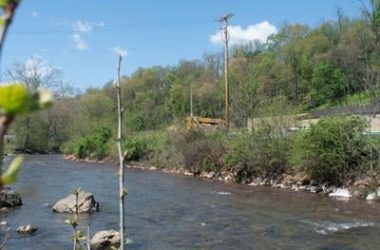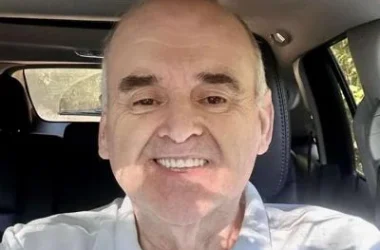By RICK STEELHAMMER
Charleston Gazette-Mail
CHARLESTON, W.Va. — As Confederate monuments across the country have been toppled, removed and attracted the attention of neo-Nazis and counter-protesters, Charleston’s Stonewall Jackson monument remains standing, though it has been the focal point of two protests over as many weeks.

(Photo by Kenny Kemp)
The September 27, 1910 unveiling of a new statue of Confederate general at the former State Capitol in downtown Charleston was preceded by a mile-long parade and drew an enthusiastic crowd of 5,000, according to a Charleston Gazette account of the event.
It also prompted William Seymour Edwards, a Kanawha County coal operator, the state’s former Speaker of the House and a long-time Republican national committeeman, to begin planning the construction and installation of a second Civil War statue — this one honoring the state’s Union soldiers.
According to the Charleston chapter of the Daughters of the Confederacy, which funded the monument, the Stonewall Jackson Statue was built to honor the memory of all Confederate soldiers from present-day West Virginia who fought in the Civil War. Fundraising and design work began on the larger-than-life bronze statue of Robert E. Lee’s most trusted and relied-upon general in 1905, after a unanimously passed joint resolution by the state Legislature gave the organization permission to place the statue on the Statehouse lawn.
The statue was sculpted by Moses Ezekiel, a former student at Virginia Military Institute in Lexington, where Jackson taught from 1851 until the war began 10 years later. Ezekiel, VMI’s first Jewish cadet, according to the institute, began his studies the year after Jackson resigned the faculty to join the Confederate cause. After a year of study, Ezekiel joined a company of cadets who left VMI to enlist in the Confederate Army. He was a corporal serving on the honor guard that escorted Jackson’s body back to VMI after the general died on May 10, 1863, from complications of friendly fire bullet wounds that resulted in the amputation of an arm following the Battle of Chancellorsville.
Ezekiel served as a sergeant during the 1864 Battle of New Market and the defense of Richmond the following year. He completed his studies at VMI after the war. Later, after studying medicine, he opted not to become a physician but instead devoted full-time attention to what had been an avocation — painting and sculpture. He moved to Europe and produced more than 200 works, and by the time he was commissioned to produce Jackson’s statue, he had been knighted by Italy’s King Victor Emmanuel in recognition of his talents.
Jackson, an orphan who grew up in the Weston area and went on to graduate from the U.S. Military Academy at West Point, served as a second lieutenant in the U.S. Army during the Mexican-American War, where he first met Lee, before resigning his commission to teach at VMI. He earned his nickname for his tenacious defense of fellow Confederates during the epic battle of First Manassas in 1861, and went on to lead troops during the battles of Fredericksburg, Antietam and Chancellorsville. In September 1862, he engineered the largest surrender of troops to occur during the Civil War, capturing 12,000 Union troops stationed at Harpers Ferry.
“The people of both causes will unite in praise of this great man, who has shown to the world the tremendous genius of the American soldier,” said Samuel Green, head of the Charleston United Confederate Veterans, during the 1910 dedication ceremony for Jackson’s statue. “He has given the generation of young men who will fight the future battles of his native land an example of the value of loyalty and study, faith and fortitude.”
Edwards, who grew up in “Bellefleur,” a now-crumbling mansion overlooking W.Va. 61 at Coalburg, was the son of William Henry Edwards, a lawyer and coal operator better known in scientific circles as the “Father of Lepidoptery,” or the study of butterflies, through which he became a student of the natural selection process and corresponded with Charles Darwin. The younger Edwards, in addition to politics and coal development, was the author of nonfiction travel-adventure stories, including “Into the Yukon,” “Through Scandanavia to Moscow,” and “On the Mexican Highlands.”
To represent the Union cause via a statue, Edwards chose the depiction of a Home Guard soldier carrying a musket and a billowing American flag. He commissioned sculptor Henry K. Bush-Brown, who, among other works, had created three equestrian statues for the Gettysburg Battlefield depicting Union generals George Meade, John F. Reynolds and John Sedgwick and their steeds.
The Mountaineer Soldier Statue, as Bush-Brown’s monument is known, was built to “commemorate the valor of those who on April 15, 1861, in instant response to the first call of Abraham Lincoln, formed themselves into the intrepid Home Guards who held in check unaided the forces of Wise, Lee and Jackson until the federal armies came.”
“It honors the fighting soul of those who laid down the pick and shovel and put aside the plow and went forward to create the mightiest army the world has ever known,” Edwards said at the statue’s dedication ceremony on December 10, 1912. Edwards bore the brunt of financing the work, which like the Jackson statue, involved no state funds.
The model for Bush-Brown’s statue was Eli “Rimfire” Hamrick, a six-foot-three mountaineer from Webster County, according to “A History of the West Virginia State Capitol” by Jim Wallace.
Gov. William Glasscock was on hand to praise the statue upon its unveiling, but told the dedication ceremony crowd (considerably smaller than that on hand for the Stonewall Jackson Statue unveiling, according to the Gazette) that for soldiers of both sides, “the greatest monument erected to them is the tower of Liberty — equal rights to all and special privileges to none.”
Both statues were relocated to the new State Capitol campus after the downtown Statehouse burned in 1921.
In 1978, the Jackson statue, at the request of the United Daughters of the Confederacy, was turned 90 degrees to look out over the Kanawha River, so that the public could view the monument from Kanawha Boulevard and California Avenue, according to “Capitols of West Virginia: A Pictorial History.”
See more from the Charleston Gazette-Mail





